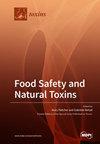牛群暴露于天然共污染的玉米赤霉烯酮和脱氧雪腐镰刀菌烯醇:尿液霉菌毒素监测系统对牛群健康和食品安全的意义
IF 3.9
3区 医学
Q2 FOOD SCIENCE & TECHNOLOGY
引用次数: 0
摘要
动物饲料中广泛存在的镰刀菌霉菌毒素是一个全球性问题,这不仅关系到牲畜的健康,也关系到最终产品的食品安全。在日本黑猪(JB)和荷斯坦弗里斯兰(HF)种猪的日粮中发现了高浓度的玉米赤霉烯酮(ZEN)和脱氧雪腐镰刀菌烯醇(DON)。因此,我们对这两种牛群的血清生化指标进行了长期监测,重点是抗苗勒管激素(AMH)水平和急性期炎症。此外,我们还测量了高频种群的尿液中 8-羟基-2′-脱氧鸟苷(8-OHdG)和孕酮水平。JB 牛群是以 ZEN 为主导的模式,DON 污染较低,但在购买的全混合日粮 (TMR) 中,其 ZEN 水平超过了日本的限制。相反,主要食用 DON 主导型饲料且 ZEN 污染较低的 HF 牛群,其玉米青贮饲料中的 DON 含量却很高。具体来说,JB 牛群的 TMR 含有 1.79 毫克/千克 ZEN 和 0.58 毫克/千克 DON,而 HF 牛群的青贮则含有 15.3 毫克/千克 DON(干样品)和 0.1 毫克/千克 ZEN。采用酶联免疫测定法测定尿液中的膳食纤维素-DON 含量,然后通过液相色谱-串联质谱法进行确认。在两个牛群中测得的尿 ZEN-DON 水平均有显著相关性(p < 0.05,r > 0.6)。在高频牛群中,受污染时和监测期结束时,AMH 水平升高(p = 0.01),血清淀粉样蛋白 A (SAA) 水平降低(p = 0.02)。此外,尿 ZEN 和 DON 水平与 SAA 水平显著相关(ZEN:p = 0.00,r = 0.46;DON:p = 0.03,r = 0.33),ZEN 和 DON 水平升高导致 SAA 水平升高。JB 牛群没有明显差异。此外,在高频牛群中,8-OHdG/Cre 水平在主要污染期间显著增加(p < 0.05)。高频牛群的临床数据表明,在重大污染期间,乳腺炎病例和治疗率均有所增加。高频牛群的流产率从 22.9%(监测前)降至 8.9%(高污染期),最后降至 1%(监测期结束时),孕酮水平也相应增加。膳魔师污染会对种牛的生产力、繁殖性能和健康产生不利影响。因此,监测尿 ZEN-DON 对检测污染物和确保食品安全很有价值。本文章由计算机程序翻译,如有差异,请以英文原文为准。
Exposure of Cattle Breeding Herds to Naturally Co-Contaminated Zearalenone and Deoxynivalenol: The Relevance of a Urinary Mycotoxin Monitoring System for Herd Health and Food Safety
The widespread presence of Fusarium mycotoxins in animal feed is a global issue, not only for the health of livestock but also for ensure the safety of food as an end product. High concentrations of zearalenone (ZEN) and deoxynivalenol (DON) have been detected in the diets of Japanese Black (JB) and Holstein Friesian (HF) breeding herds. Consequently, we monitored serum biochemical parameters over a long time in both herds, focusing on anti-Müllerian hormone (AMH) levels and acute-phase inflammation. Additionally, urinary 8-hydroxy-2′-deoxyguanosine (8-OHdG) and progesterone levels were measured in the HF herd. The JB herd, a ZEN-dominant model with low DON contamination, demonstrated ZEN levels that exceeded the Japanese limit in the purchased total mixed rations (TMR). Conversely, the HF herd, which primary consumes DON-dominant feed with low ZEN contamination, had high DON levels in the dent corn silage. Specifically, the JB herd’s TMR contained 1.79 mg/kg ZEN and 0.58 mg/kg DON, whereas the HF herd’s silage had 15.3 mg/kg DON (dried sample) and 0.1 mg/kg ZEN. Enzyme-linked immunoassay were used to measure urinary ZEN-DON levels following confirmation through liquid chromatography-tandem mass spectrometry. Urinary ZEN-DON levels measured were significantly correlated (p < 0.05, r > 0.6) in both herds. In the HF herd, AMH levels increased (p = 0.01) and serum amyloid A (SAA) levels decreased (p = 0.02) when contaminated and at the end of the monitoring period. Additionally, urinary ZEN and DON levels were significantly correlated with SAA levels (ZEN: p = 0.00, r = 0.46; DON: p = 0.03, r = 0.33), with an increase in ZEN and DON levels resulting in higher SAA levels. The JB herd showed no significant differences. Additionally, in the HF herd, 8-OHdG/Cre levels increased significantly during major contamination periods (p < 0.05). Clinical data from the HF herd indicated an increase in mastitis cases and treatment rates during periods of major contamination. Abortion rates in the HF herd decreased from 22.9% (before monitoring) to 8.9% (during the high contamination period) and finally to 1% (at the end of the monitoring period), with corresponding increases in progesterone levels. ZEN-DON contamination adversely affects breeding cattle’s productivity, reproductive performance, and health. Therefore, monitoring urinary ZEN-DON is valuable for detecting contaminants and ensuring the safety of food products.
求助全文
通过发布文献求助,成功后即可免费获取论文全文。
去求助
来源期刊

Toxins
TOXICOLOGY-
CiteScore
7.50
自引率
16.70%
发文量
765
审稿时长
16.24 days
期刊介绍:
Toxins (ISSN 2072-6651) is an international, peer-reviewed open access journal which provides an advanced forum for studies related to toxins and toxinology. It publishes reviews, regular research papers and short communications. Our aim is to encourage scientists to publish their experimental and theoretical results in as much detail as possible. There is no restriction on the length of the papers. The full experimental details must be provided so that the results can be reproduced.
 求助内容:
求助内容: 应助结果提醒方式:
应助结果提醒方式:


